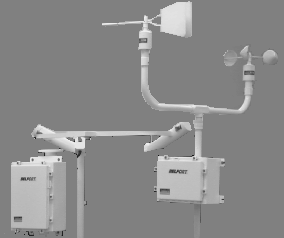General Format of the METAR/SPECI Code
METAR contains a report of wind,
visibility, runway visual range, present weather, sky condition, temperature,
dew point, and altimeter setting collectively referred to as "the body of the
report." In addition, coded and/or plain language information which elaborates
on data in the body of the report may be appended to the METAR. The
contents of the remarks will vary according to the type of weather station.
At designated stations, the METAR may be abridged to include one or more
of the above elements.
The METAR/SPECI code format has two major sections: the Body,
consisting of a maximum of 11 groups, and the Remarks, consisting of
2 categories. Together, the body and remarks make up the complete
METAR/SPECI.
The groups of the METAR code format contain a non-uniform number of
characters. When an element or phenomenon does not occur, the corresponding
group, or the extension of a group, is omitted from a particular report. The
groups enclosed in brackets are used in accordance with regional or national
decisions.
The International Format of the METAR/SPECI
Code
The following is the international format of the used by most countries. Each
group provides a link to further details concerning observing and coding
standards of the element.
United States Format of the METAR/SPECI Code
The format below is used by the United States and contains the modifications
relating to the exceptions requested by the United States.
Most exceptions deal with the units used to report certain weather elements.
Each group provides a link to further details concerning observing and coding
standards of the element.
Additional Data and Coding Missing Data in
METAR/SPECI Observations
The underline character "_" indicates a required space between the
groups. If a group is not reported, the preceding space is also not reported.
In addition to the format given, agencies shall provide for the inclusion of
any special Beginning-of-Message, End-of-Message, or End-of-Transmission
signals required by their communication system.
The actual content of a METAR or SPECI depends on the
observation program at the individual station. At designated station, the
0000, 0600, 1200, and 1800 Coordinated Universal Time (UTC) METAR's include
additional data specified by the responsible agency and are known as 6-hourly
reports. At designated stations, the 0300, 0900, 1500, and 2100 UTC METAR's
are known as 3-hourly reports and also contain additional information
specified by the responsible agency.
When an element does not occur, or cannot be observed, the corresponding group
and preceding space are omitted from that particular report.

